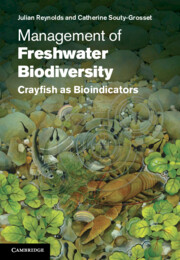Book contents
- Frontmatter
- Contents
- Preface
- Acknowledgements
- Introduction: Biodiversity in freshwater systems, and the key roles played by crayfish
- Part I The present situation of crayfish in world freshwater ecosystems
- Part II Applying science to conservation management
- Part III Knowledge transfer for successful crayfish management
- 10 Effective legislation and public education for adequate conservation of crayfish and biodiversity
- 11 Management strategies to protect crayfish and biodiversity
- 12 Maintaining biological diversity and human well-being
- References
- Glossary
- Index
- Scientific and common English names of well-studied crayfish featured in this book
- Common English and scientific names of well-studied crayfish featured in this book
- Plate section
12 - Maintaining biological diversity and human well-being
from Part III - Knowledge transfer for successful crayfish management
Published online by Cambridge University Press: 05 December 2011
- Frontmatter
- Contents
- Preface
- Acknowledgements
- Introduction: Biodiversity in freshwater systems, and the key roles played by crayfish
- Part I The present situation of crayfish in world freshwater ecosystems
- Part II Applying science to conservation management
- Part III Knowledge transfer for successful crayfish management
- 10 Effective legislation and public education for adequate conservation of crayfish and biodiversity
- 11 Management strategies to protect crayfish and biodiversity
- 12 Maintaining biological diversity and human well-being
- References
- Glossary
- Index
- Scientific and common English names of well-studied crayfish featured in this book
- Common English and scientific names of well-studied crayfish featured in this book
- Plate section
Summary
From analysis made through IUCN 2010 Red List assessments, south-east Australia was highlighted as one of the most threatened regions for crayfish species, with almost half of all species threatened with extinction. The most significant threats to these species were climate change and severe weather events, and habitat degradation and loss; while in North America habitat degradation and loss were considered a major threat, along with pollution, particularly sedimentation from land-use change. Multiple threats were found to European species with equal impacts from invasive species, pollution, and habitat degradation and loss. Madagascar was the only region in which harvesting was considered a principal threat; its impacts, though, were found to be compounded by the increasing affect of habitat fragmentation, and the long-lived nature of some of these species.
Strayer & Dudgeon (2010) have reviewed recent progress in the conservation of freshwater biodiversity. Important challenges for freshwater conservation include climate change and further freshwater extinctions, and these authors join with other voices in urging that scholarly societies, scientists, conservationists and other stakeholders must concentrate on disseminating information on conservation ecology if the world’s fresh waters are not to be dramatically impoverished.
- Type
- Chapter
- Information
- Management of Freshwater BiodiversityCrayfish as Bioindicators, pp. 285 - 288Publisher: Cambridge University PressPrint publication year: 2011

